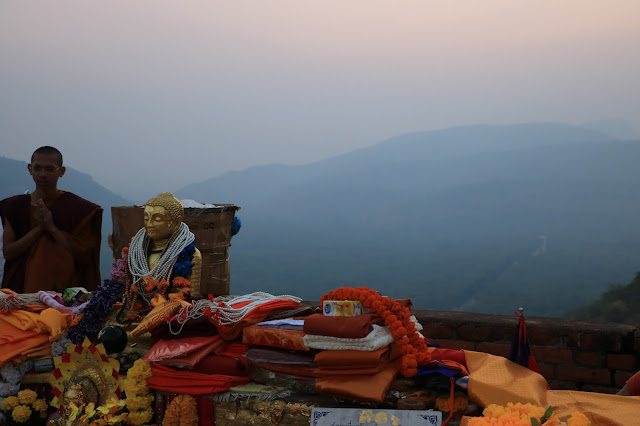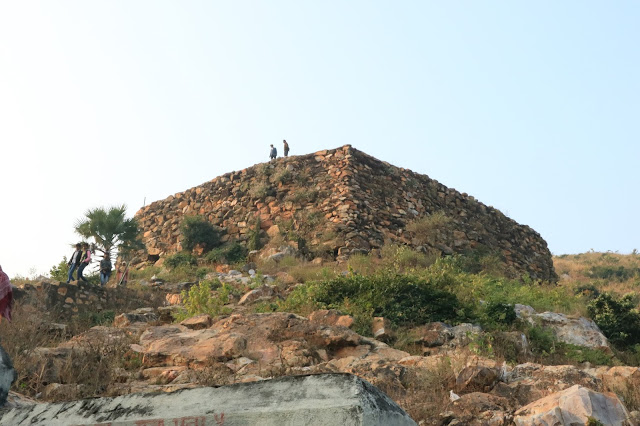Rajgir is our next stop in our Dhammayatra journey after Bodhgaya. In the Buddha's time, Rajgir was known as Rajagaha and it was the capital of the great Magadha kingdom under the reign of King Bimbisara. Surrounded by five, rocky mountains, Rajagaha has been a very important place in the Buddhist history. Before the Great Enlightenment, King Bimbisara had an encounter with ascetic Gotama here in Rajagaha. The King offered half of his kingdom to the ascetic, but was rejected. Knowing about his firm mission, the King requested Ascetic Gotama to return to Rajagaha after enlightenment and teach the King the path to purification. The going forth of Upadissa Sariputta and Kolita Moggallana had happened in Rajagaha after the famous encounter between Sariputta and Ven. Assaji, one of the first five monks to be ordained in Isipatana. The first ever monastery in history, the Bamboo Grove or Veluvana was also located in Rajagaha. Besides that, Vulture's Peak (Gijjhakuta), Cave of the Seven Leaves (Sattapanni Guha) and Jivaka's Mango Grove, places significant to some of the discostreurses, were located in Rajagaha. The miracle taming of the rampaging elephant, Nalagiri, by the Blessed One was happened in the middle of this Rajagaha street. Rajagaha is also well-known for the residence of many spiritual brahmins, including the founder of Jainism, brahmin Nigantha Nataputta. Rajagaha at that time was surrounded by rocky fords established on the hills. King Ajatasattu, prince of King Bimbisara expanded the kingdom beyond the fort (New Rajagaha) after taking over his father's throne. Subsequently, King Bimbisara's grandson, King Udayibhadda then expanded the kingdom to Pataliputta (known as Patna today) by the river of Ganga.
 |
| View of Old Rajagaha from Gijjhakuta |
Bamboo Grove (Veluvana)
Bamboo grove or commonly known as Veluvana in the suttas or Venuvan by the locals is the first ever park monastery donated by King Bimbisara to Lord Buddha during His first invited meal in Rajagaha. The grove was previously a private retreat place for the kings. Lord Buddha had spent
 |
| Entrance to Veluvana |
 |
| Karanda kanivapa in the middle of Veluvana |
Ye dhammā hetuppabhavā
Tesam hetum Tathāgato āha
Tesañca yo nirodho
Evam-vādī Mahā-samano
"Of those phenomena that originate from a cause, the Tathāgata has declared the cause, and also what their cessation is. This is the doctrine of the Great Samana." Upon listening to Ven. Assaji's words, Sariputta gained the first stage of fruition and became Sotapan. Sariputta then converted Ven. Assaji's words to his friend, Moggallana, and he too gain Sotapan upon hearing the utterance. Sariputta then converted the utterance to his teacher, Sanjaya, and invited him to become Lord Buddha's disciple, but was rejected, exclaiming that for him, Sanjaya to become someone's disciple is like turning a jar into a drinking cup. Ven. Sariputta, after becoming a disciple of Lord Buddha, related this occurrence to the Lord. Lord Buddha then spoke in the following verses:
Asare saramatino
Sare casaradassino
Te saram nadhigacchanti
Micchasankapagochara
Saranca sarato natva
Asarancha adhigacchanti
Te saram adhigacchanti
Sammasankapagocara
"What is unessential they take it as essential, what is essential they take it as unessential, such person can never realise the Truth, for they hold wrong views. What is essential they take it as essential, what is unessential they take it as unessential, such person will realise the Truth, for they hold right views." This verses were from Dhammapada, verses 11 and 12.
Here in Veluvana, Bro Tan also reminded us not to be conceited or be judgmental of others during our practise, but instead be mindful of our own actions, speech and thoughts.
Na paresam vilomani
Na paresam katakatam
Attanova avekkhayya
Katani akatani ca
“Don't consider others' faults, those done and left undone by others, but consider one's own deeds, those done and left undone." (Dhp 50). As a Buddhist practitioner, we have to be mindful and aware of such unwholesome thought arising and abandon this thought, disallowing the establishment of conceit within ourselves.
 |
| Bamboo Grove, Veluvana |
Bimbisara Jail
This site, containing just 60m square of enclosed 2m-thick stone wall remains, was identified as the prison where King Bimbisara was jailed by his prince, King Ajattasattu, after usurping the throne from his father. Here is where the sad drama happened to King Bimbisara as whom his prince, King Ajattasattu desired to kill for the sake of power. King Ajattasattu ordered the barber in-charge of doing the King's shaving to cut of King Bimbisara's vein during the shaving. The moment King Ajattasattu became a father, he regained his consciousness on all his evil deeds done against his father, but it's too late for him to stop the killing act as King Bimbisara had passed away the moment King Ajattasattu gain conscience.
Jivaka's Mango Grove (Jivaka ambavana)
Right at the foot of the Gijjhakuta is the Jivaka's mango grove or Jivaka ambavana dedicated by Jivaka, the great physician in Rajagaha at that time, to the Sangha community. A few sutta related to Jivaka including a discourse explaining the three types of meat that are forbade to be offered to the Buddha (MN 55).
Right at the foot of the Gijjhakuta is the Jivaka's mango grove or Jivaka ambavana dedicated by Jivaka, the great physician in Rajagaha at that time, to the Sangha community. A few sutta related to Jivaka including a discourse explaining the three types of meat that are forbade to be offered to the Buddha (MN 55).
 |
| Jivaka Ambavana |
Maddakucchi
Maddakucchi is a spot located just beside the pathway towards Gijjhakuta. This is the place where Kosala devi, the queen of King Bimbisara tried to abort Prince Ajattasattu by rubbing hard onto her belly. This spot also happened to be the spot where Devadatta tried to murder Lord Buddha by triggering a big boulder to befall on Him. Lord Buddha was unhurt due to the boulder knocking on another rock, resulting in the breaking of the boulder. However, the fragments of the boulder managed to cause injury to Lord Buddha.
 |
| Maddakucchi |
Vulture's Peak (Gijjhakuta)
Vulture's Peak or Gijjhakuta is the second resting place for Lord Buddha and His disciples after alms-round aside from Veluvana. Gijjhakutta is a very holy site, especially to Mahayana devotees. Its believed that the Mahayana's Surangama Sutra was expounded here in Gijjhakuta. A few suttas including the Mahaparinibbana Sutta (DN16) was expounded here.
 |
| Vulture's Peak, Gijjhakuta |
Sattapanni Cave (Sattapanni Guha)
The cave of the seven leaves or known as the Sattapanni Cave was the spot where the first Buddhist rehearsal was held, led by Ven. Maha Kassapa. Located on Vebhara Hill cliff of Rajagaha, Sattapanni Cave was the third resting area for the Lord Buddha and His disciples. Along the way up to the cave, we would pass by an old hot spring, Pippali House and a few Jainism temples. The Pipphali House was once a watchtower of the Rajagaha fort. After Rajagaha had expanded, the watchtower was abandoned.Ven. Maha Kassapa would frequently go for his seclusion here in the house.
 |
| Pipphali House |
Nalanda
Located just north of Rajagaha is the town of Nalanda, the place where Ven. Sariputta and Ven. Moggallana came from. The city also contained the site where the ancient Nalanda Mahavihara was located. Nalanda Mahavihara, or commonly known as the Nalanda University was the alma mater of Ven. Tsuan Hsang who had travelled far from Chang'an to Nalanda to seek for the Vinaya around AD 629 to 645. Nalanda Mahavihara has been a renown academic institution to the Buddhist scholars at that time, especially those from the Southeast Asia. In addition a monastery, known as the Monastery No. 1 was believed to be fully sponsored by the ancient Srivijaya Kingdom, which was once a strong kingdom in the current Indonesia. Unfortunately, the Muslim extremist Turuskas or Khaliji Turks from Afghanistan dealt a fatal blow against the university around early 12th century AD. Lead by Muhammad Bakhtiyar Khaliji, a savage massacre was committed towards all the bhikkhus in the institute, with no one left alive. As no one could acquaint the killers of the contents of books stored in the Mahavihara's library, the library was burned down, using up to three months. It was indeed an drastic event for us to reflect on the impermanence of Buddhism and how we should deal with it instead of folding arms and doing nothing about it. The layout of the Nalanda Mahavihara was illustrated in the Nalanda Archaeological Museum located just opposite of the site. Artifacts unearthed at the site were also exhibited in the museum.
 |
| A portion of the ruins of Nalanda Mahavihara |
 |
| Ruins of Nalanda Mahavihara monasteries |
 |
| A portion of the ruins of Nalanda Mahavihara, believed to be the main shrine hall |
Just a few distance away from the site is the Tsuan Hsang Memorial Hall. Fully funded by the Chinese Government, the complex was established to commemorate Ven. Tsuan Hsang, whose detailed records had contributed to the discoveries of many Buddhist holy sites.
 |
| The Hsuan Tsang Memorial Hall |
That's all for Rajagaha, the place where the first ever monastery, Veluvana, was established upon the arrival of Lord Buddha in the ancient kingdom of Rajagaha from Uruvela after converting 1000 disciples of the Kassapa Brothers in Gayasisa.
My Dhammayatra journey continues...


No comments:
Post a Comment